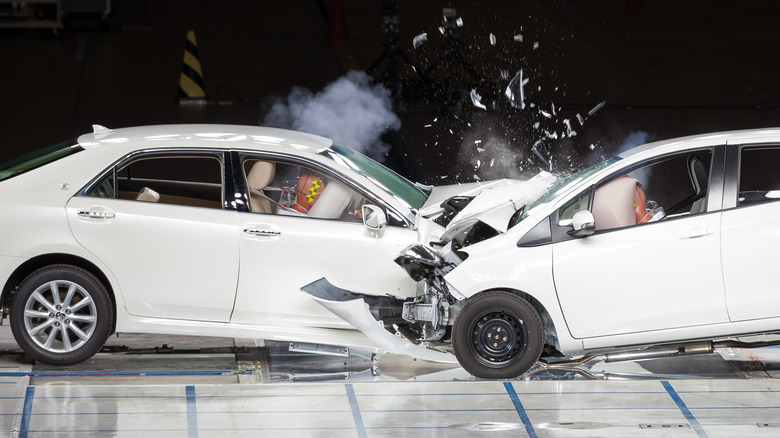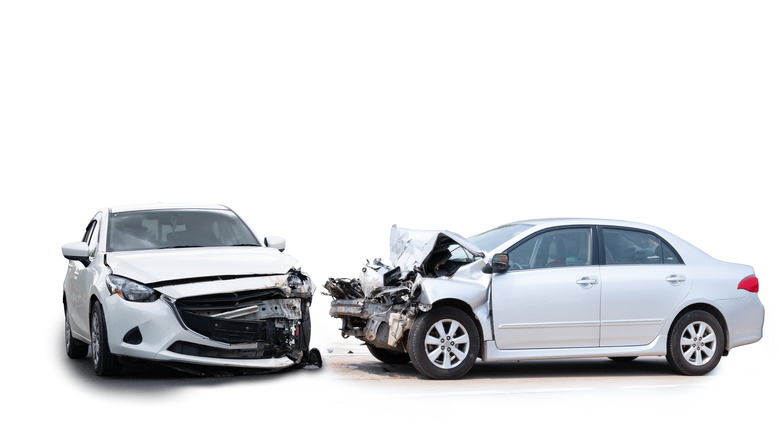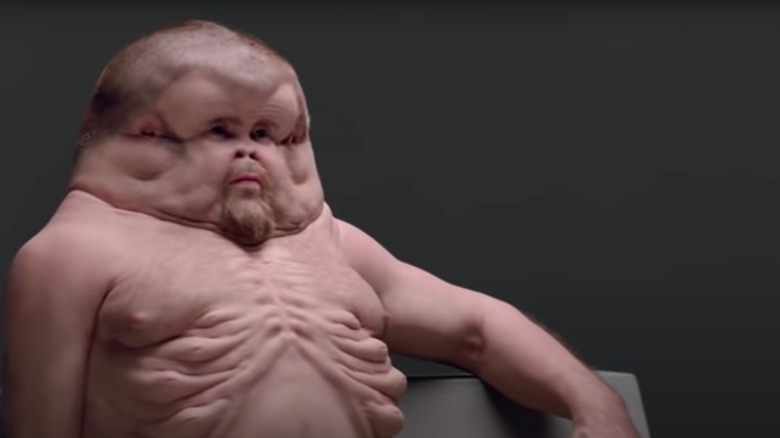What Humanity Would Look Like If It Had Evolved To Survive Car Crashes
It may surprise you to learn that your body cannot withstand the impact forces of a car driving at just under 19 miles per hour. Our species simply did not evolve in an environment where blocks of steel zoom all over the place. According to Victoria's Transport Accident Commission, "a pedestrian or a cyclist is struck by a car traveling at 30km per hour (19 mph) or more, their chances of dying start to increase, and by 60km per hour (37 mph) an hour there's almost no chance of surviving" (via Simple).
With this in mind, the government of the Australian state of Victoria decided to run a campaign called Towards Zero, with the idea that if they raised awareness of the human body's frailty, people might drive roads more carefully, perhaps resulting in zero fatalities due to collisions. The Victorian government decided to pose an interesting question in a set of public service announcements: what if human beings evolved over time and developed characteristics that would be beneficial for surviving car crashes?
How human evolution works
Evolution is the process through which organisms change over generations. According to National Geographic, Charles Darwin is credited with pitching the idea that evolution occurs thanks to natural selection. This is when organisms with traits better suited to survive live, while others in the population do not. The traits that helped the living organism survive are then passed on to its offspring and over time — a lot of time — the entire species can change.
According to Britannica, humans first emerged around 315,000 years ago after developing traits that were better suited for their environment, like walking upright on two legs and the ability to develop and use tools. Evolution is a slow process that unfolds over thousands of years, this is why in the short time that cars have been around humans haven't yet adapted to the danger they can pose. However, at some point, thousands of years down the line, they might.
Towards Zero needed a way to get peoples' attention
In 2015, when the state government of Victoria decided to launch their Towards Zero initiative — which seeks to someday make the number of vehicle accident fatalities zero — they decided to put together a campaign to raise public awareness. Traditionally, these kinds of campaigns rely on heavy displays of shock and gore — cars rocketing into the air, people mangled, and so on. The team wanted to focus on the scientific aspects of their goal without losing the visceral quality.
"We needed to find a way to communicate that to people but not make them feel like it was a cold, clinical data point," Head of Planning at DDB Group Australia, Matt Pearce, said to Simple. "We decided to just focus on the human form. It's something everyone can relate to because it's about how we're all built."
And so, they developed Graham, — a composite model of what a human man may look like and be built like if the humans evolved to survive car crashes. "Through Graham," Pearce said, "We could talk about why we need airbags, seatbelts, speed limits — he allows us to address all of these things."
Meet Graham
By illustrating how radically different we would look if human bodies had evolved to include the biological equivalents of automotive safety equipment, the team hoped to display just how important driving carefully really is. Visitors to the Towards Zero website can click on different parts of Graham's body, like his brain, to see how the team, comprised of a trauma surgeon, a crash expert, and an artist redesigned the human body.
"Graham's brain is the same as yours, but his skull is a lot bigger, with more cerebrospinal fluid and ligaments to brace the brain when a collision occurs. His head offers greater overall safety, effectively protecting the brain and reducing the damage caused on internal impact with the skull wall," Patricia Piccinini, the artist who created the life-sized Graham sculpture, said. Similar measures were taken for the other parts of Graham's body which are frequently injured in modern humans, including a strengthened rib cage with small airbags between each rib and an ultra-sturdy neck to protect against whiplash.
Graham was certainly attention grabbing
According to Simple's profile, 77% of those who saw images of Graham or who saw the model in person reported it made them realize "their own fragility when thinking about road safety." CNN reported Graham was originally displayed at the State Library of Victoria but then went on tour around the country as a traveling display to spread Towards Zero's message on the importance of road safety and reducing traffic fatalities.
Of course, given Graham's unusual appearance, he and the campaign were eventually spoofed. A few years after Graham made his rounds, a parody of Graham was released. He was called Grant, and he was described as "designed to survive the trauma of a career in advertising," by physically evolving to endure "dangerously long hours, self-induced stress and rampant alcoholism." According to The Drum, those evolutionary traits looked like "Ears that filter out conflicting opinions," and "An auxiliary liver to process copious amounts of alcohol" among others.




